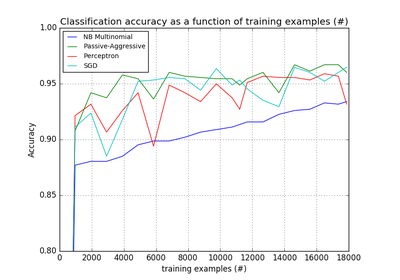sklearn.feature_extraction.text.HashingVectorizer¶
-
class
sklearn.feature_extraction.text.HashingVectorizer(input='content', encoding='utf-8', decode_error='strict', strip_accents=None, lowercase=True, preprocessor=None, tokenizer=None, stop_words=None, token_pattern='(?u)\b\w\w+\b', ngram_range=(1, 1), analyzer='word', n_features=1048576, binary=False, norm='l2', non_negative=False, dtype=<class 'numpy.float64'>)[源代码]¶ Convert a collection of text documents to a matrix of token occurrences
It turns a collection of text documents into a scipy.sparse matrix holding token occurrence counts (or binary occurrence information), possibly normalized as token frequencies if norm=’l1’ or projected on the euclidean unit sphere if norm=’l2’.
This text vectorizer implementation uses the hashing trick to find the token string name to feature integer index mapping.
This strategy has several advantages:
- it is very low memory scalable to large datasets as there is no need to store a vocabulary dictionary in memory
- it is fast to pickle and un-pickle as it holds no state besides the constructor parameters
- it can be used in a streaming (partial fit) or parallel pipeline as there is no state computed during fit.
There are also a couple of cons (vs using a CountVectorizer with an in-memory vocabulary):
- there is no way to compute the inverse transform (from feature indices to string feature names) which can be a problem when trying to introspect which features are most important to a model.
- there can be collisions: distinct tokens can be mapped to the same feature index. However in practice this is rarely an issue if n_features is large enough (e.g. 2 ** 18 for text classification problems).
- no IDF weighting as this would render the transformer stateful.
The hash function employed is the signed 32-bit version of Murmurhash3.
Read more in the User Guide.
Parameters: input : string {‘filename’, ‘file’, ‘content’}
If ‘filename’, the sequence passed as an argument to fit is expected to be a list of filenames that need reading to fetch the raw content to analyze.
If ‘file’, the sequence items must have a ‘read’ method (file-like object) that is called to fetch the bytes in memory.
Otherwise the input is expected to be the sequence strings or bytes items are expected to be analyzed directly.
encoding : string, default=’utf-8’
If bytes or files are given to analyze, this encoding is used to decode.
decode_error : {‘strict’, ‘ignore’, ‘replace’}
Instruction on what to do if a byte sequence is given to analyze that contains characters not of the given encoding. By default, it is ‘strict’, meaning that a UnicodeDecodeError will be raised. Other values are ‘ignore’ and ‘replace’.
strip_accents : {‘ascii’, ‘unicode’, None}
Remove accents during the preprocessing step. ‘ascii’ is a fast method that only works on characters that have an direct ASCII mapping. ‘unicode’ is a slightly slower method that works on any characters. None (default) does nothing.
analyzer : string, {‘word’, ‘char’, ‘char_wb’} or callable
Whether the feature should be made of word or character n-grams. Option ‘char_wb’ creates character n-grams only from text inside word boundaries.
If a callable is passed it is used to extract the sequence of features out of the raw, unprocessed input.
preprocessor : callable or None (default)
Override the preprocessing (string transformation) stage while preserving the tokenizing and n-grams generation steps.
tokenizer : callable or None (default)
Override the string tokenization step while preserving the preprocessing and n-grams generation steps. Only applies if
analyzer == 'word'.ngram_range : tuple (min_n, max_n), default=(1, 1)
The lower and upper boundary of the range of n-values for different n-grams to be extracted. All values of n such that min_n <= n <= max_n will be used.
stop_words : string {‘english’}, list, or None (default)
If ‘english’, a built-in stop word list for English is used.
If a list, that list is assumed to contain stop words, all of which will be removed from the resulting tokens. Only applies if
analyzer == 'word'.lowercase : boolean, default=True
Convert all characters to lowercase before tokenizing.
token_pattern : string
Regular expression denoting what constitutes a “token”, only used if
analyzer == 'word'. The default regexp selects tokens of 2 or more alphanumeric characters (punctuation is completely ignored and always treated as a token separator).n_features : integer, default=(2 ** 20)
The number of features (columns) in the output matrices. Small numbers of features are likely to cause hash collisions, but large numbers will cause larger coefficient dimensions in linear learners.
norm : ‘l1’, ‘l2’ or None, optional
Norm used to normalize term vectors. None for no normalization.
binary: boolean, default=False. :
If True, all non zero counts are set to 1. This is useful for discrete probabilistic models that model binary events rather than integer counts.
dtype: type, optional :
Type of the matrix returned by fit_transform() or transform().
non_negative : boolean, default=False
Whether output matrices should contain non-negative values only; effectively calls abs on the matrix prior to returning it. When True, output values can be interpreted as frequencies. When False, output values will have expected value zero.
Methods
build_analyzer()Return a callable that handles preprocessing and tokenization build_preprocessor()Return a function to preprocess the text before tokenization build_tokenizer()Return a function that splits a string into a sequence of tokens decode(doc)Decode the input into a string of unicode symbols fit(X[, y])Does nothing: this transformer is stateless. fit_transform(X[, y])Transform a sequence of documents to a document-term matrix. get_params([deep])Get parameters for this estimator. get_stop_words()Build or fetch the effective stop words list partial_fit(X[, y])Does nothing: this transformer is stateless. set_params(**params)Set the parameters of this estimator. transform(X[, y])Transform a sequence of documents to a document-term matrix. -
__init__(input='content', encoding='utf-8', decode_error='strict', strip_accents=None, lowercase=True, preprocessor=None, tokenizer=None, stop_words=None, token_pattern='(?u)\\b\\w\\w+\\b', ngram_range=(1, 1), analyzer='word', n_features=1048576, binary=False, norm='l2', non_negative=False, dtype=<class 'numpy.float64'>)[源代码]¶
-
decode(doc)[源代码]¶ Decode the input into a string of unicode symbols
The decoding strategy depends on the vectorizer parameters.
-
fit_transform(X, y=None)[源代码]¶ Transform a sequence of documents to a document-term matrix.
Parameters: X : iterable over raw text documents, length = n_samples
Samples. Each sample must be a text document (either bytes or unicode strings, file name or file object depending on the constructor argument) which will be tokenized and hashed.
y : (ignored)
Returns: X : scipy.sparse matrix, shape = (n_samples, self.n_features)
Document-term matrix.
-
fixed_vocabulary¶ DEPRECATED: The fixed_vocabulary attribute is deprecated and will be removed in 0.18. Please use fixed_vocabulary_ instead.
-
get_params(deep=True)[源代码]¶ Get parameters for this estimator.
Parameters: deep: boolean, optional :
If True, will return the parameters for this estimator and contained subobjects that are estimators.
Returns: params : mapping of string to any
Parameter names mapped to their values.
-
partial_fit(X, y=None)[源代码]¶ Does nothing: this transformer is stateless.
This method is just there to mark the fact that this transformer can work in a streaming setup.
-
set_params(**params)[源代码]¶ Set the parameters of this estimator.
The method works on simple estimators as well as on nested objects (such as pipelines). The former have parameters of the form
<component>__<parameter>so that it’s possible to update each component of a nested object.Returns: self :
-
transform(X, y=None)[源代码]¶ Transform a sequence of documents to a document-term matrix.
Parameters: X : iterable over raw text documents, length = n_samples
Samples. Each sample must be a text document (either bytes or unicode strings, file name or file object depending on the constructor argument) which will be tokenized and hashed.
y : (ignored)
Returns: X : scipy.sparse matrix, shape = (n_samples, self.n_features)
Document-term matrix.




